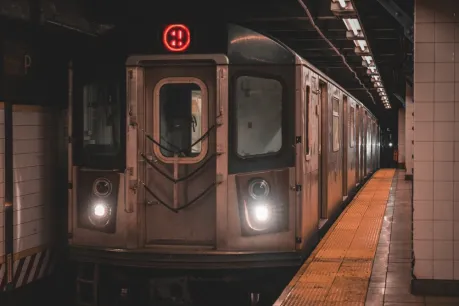Injured in a Train Accident in New York City? Here’s What to Do in New York

Injured?
New York’s railways are a lifeline for millions of commuters, residents, and tourists. But when that lifeline breaks, when a train derails, a platform collapses, or an operator misses a critical signal, the consequences can be devastating. In a city that depends so heavily on trains, one moment of negligence can ripple through countless lives, leaving behind serious injuries, financial hardship, and emotional trauma.
If you’ve been injured in a subway, commuter rail, or Amtrak accident in New York, you may be entitled to compensation. But train accident cases aren’t like typical personal injury claims. These cases often involve powerful public agencies, private rail operators, and a maze of regulations that require an experienced legal team to navigate effectively.
Common Causes of Train Accidents in New York
Train accidents aren’t usually caused by freak occurrences; they’re the result of human error, failed oversight, or flawed infrastructure. In New York City, some of the most common causes of train accidents include:
- Track or signal malfunctions
- Overcrowded platforms and cars
- Mechanical failures due to poor maintenance
- Operator fatigue or distraction
- Obstructions on the track
- Environmental hazards like flooding or debris
- Negligent safety inspections
Even minor oversights can escalate into tragic events, such as derailments, crashes, falls onto the tracks, or violent jolts during emergency braking. These are not acceptable risks. When safety protocols are ignored or outdated systems are allowed to fail, the people in charge should be held accountable.
Injuries From Subway and Train Accidents
The injuries from a train accident can vary widely depending on the circumstances, but few victims walk away unscathed. Some of the most common physical and emotional injuries include:
- Traumatic brain injuries
- Broken bones and crush injuries
- Spinal cord damage
- Burns or electrocution
- PTSD, anxiety, and long-term psychological trauma
Injuries don’t only happen inside the trains. Pedestrians struck at crossings, construction workers near tracks, and bystanders caught in the aftermath can all suffer serious harm. And when injuries happen, victims deserve a clear path to recovery, not excuses or delays from insurance companies or rail operators.
Can You Sue the MTA or a Private Rail Company?
In many cases, yes, but it depends on who operates the train. If the MTA or a city-run subway is involved, your claim may follow a different process than a case against a private company like Amtrak or a tourist rail service. Filing against a public agency typically means shorter deadlines and stricter filing procedures, so time is of the essence.
Morgan & Morgan has handled lawsuits against both public and private rail entities across the country. Whether it’s a city train or a national rail carrier, our attorneys know how to build a case that sticks.
What to Do After a Train Accident
If you’ve just experienced a train accident, your priority should always be your health. Seek immediate medical care, even if you think you’re okay. Some injuries, like concussions or internal bleeding, may not show symptoms right away but can worsen quickly without treatment.
To help the validity of your case, try to:
- Document the scene (photos, videos, witness names)
- Save your medical records and discharge notes
- Avoid discussing fault or posting about the incident online
- Do not give a recorded statement to insurance adjusters without speaking to a lawyer first
Every detail counts. Surveillance footage, maintenance logs, and operator history may all play a role in proving your case, and the sooner an attorney gets involved, the better the chances of preserving that critical evidence.
Damages You May Be Entitled To
No two train accident cases are alike, but victims may be eligible to recover compensation for a wide range of losses, including:
- Emergency medical bills and future care
- Lost wages and lost earning potential
- Physical therapy and long-term rehabilitation
- Pain and suffering
- Emotional distress
- Property damage
- Wrongful death and funeral costs (for family members)
Calculating the full value of your claim involves more than just adding up receipts. A skilled attorney will account for how your injuries affect your daily life, your future, and your ability to return to normal, because that’s what justice really looks like.
Who’s Liable in a New York Train Derailment?
Liability can fall on multiple parties depending on what went wrong. That could include:
- The train operator (if distracted, intoxicated, or fatigued)
- The transit agency (for maintenance failures or training issues)
- A private rail company (for equipment or operational errors)
- Third-party contractors (who failed inspections or safety repairs)
- Manufacturers (for defective parts or warning systems)
Determining who is legally responsible often requires an in-depth investigation. Collaboration with engineers, forensic experts, and transportation specialists may all be needed to identify the root causes and construct the strongest case possible.
The Role of Surveillance Footage and Documentation
In subway and commuter train accidents, surveillance footage can make or break your case. Most platforms and railcars are equipped with cameras, and obtaining this footage as early as possible is essential. Our legal team sends immediate evidence preservation letters to ensure that no one deletes or overwrites key records.
In addition to footage, we’ll also review:
- Incident reports
- Medical evaluations
- Witness statements
- Safety inspection logs
- Maintenance records
The more detailed your documentation, the stronger your foundation for seeking maximum compensation.
Train Accident Lawsuits: What to Expect
Filing a lawsuit may sound intimidating, especially while you’re recovering, but you won’t be doing it alone. When you work with Morgan & Morgan, we handle every aspect of the process, including evidence gathering, filing, negotiation, and, if necessary, trial preparation.
Some cases settle in a few months. Others, especially when public agencies are involved, may take longer. But no matter how complex your case, our goal is always the same: justice without compromise.
Wrongful Death in NYC Train Accidents
Sadly, some train accidents result in fatalities. In those cases, surviving family members may be able to file a wrongful death lawsuit. Compensation can help cover funeral expenses, lost income, and the emotional distress caused by the loss of a loved one due to negligence. Our firm takes these cases personally, and we fight with everything we’ve got.
Morgan & Morgan: Taking on Train Accident Cases Nationwide
We’ve represented victims in some of the most difficult times of their lives. In New York and beyond, we bring the same level of grit, resources, and dedication to every case, regardless of its size or scope. If you or someone you love has been injured in a train accident, don’t let legal deadlines or red tape keep you from getting what you’re owed.
Let’s Talk About Your Case
At Morgan & Morgan, we offer free case evaluations, and you’ll never pay upfront for our services. If we take your case, we only get paid if you win. It’s that simple.
Train accidents leave behind more than wreckage; they leave behind real people with real injuries. We’re here to help them move forward.


